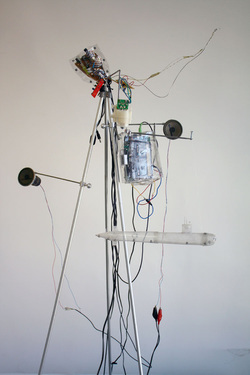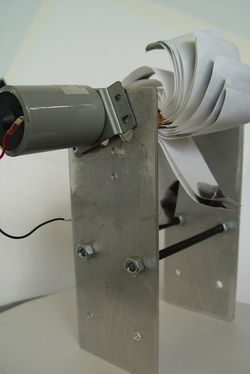Electronic and Kinetic Work
Simultaneous Sensor Series, 2013-2014
Title: Simultaneous Variable Sensing Device #1
Materials: Electronics, LCD, Geiger-Müller tube, Voltage Regulator, 12v Adapter
Dimensions: 2.5" x 5" x 1"
Date Created: 2013
As part of a larger series, Simultaneous Variable Sensing #1, detects ionizing radiation—alpha, beta particles and gamma rays exemplifying the recent phenomenon of real-time reporting using sensory devices. The creation of this work signals an awareness of the potent hidden forces that occupy space and coexist in a world that we often regard as concrete and structured rather than multi-dimensional and variable. The sensor creates a situation whereby the specificity of a site is made known by the awareness of energy particles detected rather than a human history comprised of social, cultural interactions. The sensor detects these ancient particles amidst human-centred everyday reality. The final work is will be comprised of the total number of particles calculated over the course of an exhibition signifying duration and the space in which it is placed.
Materials: Electronics, LCD, Geiger-Müller tube, Voltage Regulator, 12v Adapter
Dimensions: 2.5" x 5" x 1"
Date Created: 2013
As part of a larger series, Simultaneous Variable Sensing #1, detects ionizing radiation—alpha, beta particles and gamma rays exemplifying the recent phenomenon of real-time reporting using sensory devices. The creation of this work signals an awareness of the potent hidden forces that occupy space and coexist in a world that we often regard as concrete and structured rather than multi-dimensional and variable. The sensor creates a situation whereby the specificity of a site is made known by the awareness of energy particles detected rather than a human history comprised of social, cultural interactions. The sensor detects these ancient particles amidst human-centred everyday reality. The final work is will be comprised of the total number of particles calculated over the course of an exhibition signifying duration and the space in which it is placed.

Stormy Weather, 2012
In this work samples from sound effects albums of rain and thunder (both popular themes) are reproduced through a mechanical pencil lead connected to a positive end of a speaker wire. In effect the electricity is passed through the graphite from a brush connected to the record itself. Part drawing and part sound work the graphite particles and the sound grooves merge and create something new apart from the normal wear-and-tear on the vinyl from a diamond stylus.
In this work samples from sound effects albums of rain and thunder (both popular themes) are reproduced through a mechanical pencil lead connected to a positive end of a speaker wire. In effect the electricity is passed through the graphite from a brush connected to the record itself. Part drawing and part sound work the graphite particles and the sound grooves merge and create something new apart from the normal wear-and-tear on the vinyl from a diamond stylus.
Fog Factory, 2007 Note: Work no longer exists due to storage issues
Fog Factory, 2007, recycled steel, cast-off polyethylene terephthalate (P.E.T.) plastic bottles, rivets, fog machine, timers and proximity sensors, pre-fabricated trailer, 213 x 305 x 152 cm
The Fog Factory is a portable structure, designed to be, positioned within various ‘public’ locations, in an urban environment. As disposable architecture, it utilizes recyclables in its construction and reflects the transient use of plastics as cast-off material from the oil industry. Its utter failure, as a functional structure, directs the viewer’s attention to its unreliability, a challenge to the utopian idea of sustainability. Acting as a metaphor for reassessment of urban systems, architecture and the way sculpture ‘functions’, the fog factory references the industrial revolution, (steam power and metal construction), and the transferring of energy that also takes place in the body as a way to convert calories into heat energy. In the construction one imagines an absence, the unseen refuse as the other of consumption, which gives shape to part of the structure. The stacks mimic the industrial city as the fog rises and fades. It focuses in on the current state of culture the bewilderment of position the challenges of ideas regarding selfhood, presence, truth, origin and identity. Upon first reading, the structure appears merely to be ecologically charged, activist in nature, haunted by the ambitions of generations that have attempted, democratically, to redirect environmental reform. Yet the work is fraught with contradiction, its creation is dependent upon the forces of capitalism and modernity—gasoline power, electricity, steel manufacturing, and plastic production.
The Fog Factory is a portable structure, designed to be, positioned within various ‘public’ locations, in an urban environment. As disposable architecture, it utilizes recyclables in its construction and reflects the transient use of plastics as cast-off material from the oil industry. Its utter failure, as a functional structure, directs the viewer’s attention to its unreliability, a challenge to the utopian idea of sustainability. Acting as a metaphor for reassessment of urban systems, architecture and the way sculpture ‘functions’, the fog factory references the industrial revolution, (steam power and metal construction), and the transferring of energy that also takes place in the body as a way to convert calories into heat energy. In the construction one imagines an absence, the unseen refuse as the other of consumption, which gives shape to part of the structure. The stacks mimic the industrial city as the fog rises and fades. It focuses in on the current state of culture the bewilderment of position the challenges of ideas regarding selfhood, presence, truth, origin and identity. Upon first reading, the structure appears merely to be ecologically charged, activist in nature, haunted by the ambitions of generations that have attempted, democratically, to redirect environmental reform. Yet the work is fraught with contradiction, its creation is dependent upon the forces of capitalism and modernity—gasoline power, electricity, steel manufacturing, and plastic production.
Reversal Sublimation, 2008

Rivets, polyethylene terephthalate (P.E.T.) plastic, aluminum tripod, motor In this work the sub is attached to a motor, which stops and starts in a repetitive fashion, circling about in reverse. The term sublimation is taken from Freud who thought that it functioned as a socially acceptable escape valve for excess sexual energy, which would otherwise have to be discharged in socially unacceptable forms i.e. in neurotic symptoms. The reversal in this case refers to the reversal of its expression in militaristic forms not necessarily scientific. This piece attempts to reconcile this adaptation of humans to transcend or re-channel this energy into other pursuits whether they are fantastic in the Lacanian sense or Freudian in the sense that they become another object. In this case the object of the sub is often thought of as a cigar shape further attaching it to a patriarchal symbolic order.
Motorized Flip-book, 2002

This was an attempt to make a motorized flip-book with a photographic animation of me drawing zero backwards and forwards.
Binary Oppositional Discussion on Rainforest Policy, 1991

wood, sound, sound sensors, motors, movable mouths
150 cm x 45 cm
This double-mouthed creature discussed a text that McDonald’s Corporation disseminated to explain its position on the rainforests, often destroyed to make room for cattle grazing. The automaton “spoke” with the aid of a tascam four-track connected to sound sensors that activated motors attached to its double mouth. This machine would seem to argue with itself about the issue.
